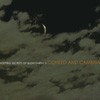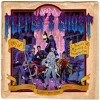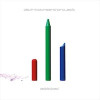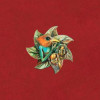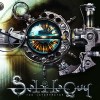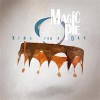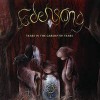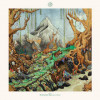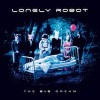Ultimately, progress will not be stopped. Pain of Salvation have been firmly at the forefront of the progressive rock and metal scenes for nearly three decades now. Led by mercurial multi-instrumentalist Daniel Gildenlöw, the Swedish band have consistently demonstrated a sincere passion for moving their own extraordinary music forward, while always remaining lyrically enlightened and ferociously intelligent. As a result, the band’s return in 2020 could hardly be better timed.Since selecting the Pain of Salvation banner back in 1991, Gildenlöw’s crew have arguably been the definitive prog band of the modern era. From elaborate and pointedly metallic early classics like The Perfect Element, Part I (2000) and Remedy Lane (2002) to the obtuse wizardry of Be (2004) and the genre-blurring mischief of Scarsick (2006), Pain of Salvation’s all-encompassing musical vision has delivered some of contemporary prog’s most brave, bold and startling moments. Perennially restless, the band switched to a more retrogressive style for Road Salt One (2010) and Road Salt Two (2011), conjuring a precocious blend of ‘70s blues rock and proto-metal with Gildenlöw’s unerringly inventive instincts.Also one of modern rock’s most revered and acclaimed live acts, Pain of Salvation reached a new peak of efficacy on 2017’s In The Passing Light Of Day, an intricate but soulful concept piece that focused on notions of mortality and joy. Both a technically dazzling metal band and a freewheeling prog ensemble, Pain of Salvation have earned their formidable reputation by simply being their brilliant, creatively fearless selves.Fast forward to 2020 and the world is in a state of disarray. But music’s power to uplift and unite has never been in doubt, and the new Pain of Salvation album PANTHER is guaranteed to provide prog fans with a much-needed dose of sumptuous musical substance. Since the release of In The Passing Light Of Day, the band have deftly weathered the departure of guitarist Ragnar Zolberg, discovering a newfound enthusiasm for what happens next in the process.“We did In The Passing Light Of Day and that ended with the departure of Ragnar from the band,” Gildenlöw recalls. “In the past, 10 or 20 years ago, that would probably have made me doubt the future of the band and all of that. I went through that a lot in the past with members leaving or things not turning out in a good way! It’s always difficult and it’s always something that makes you sad, when your little band family is disrupted, but I never came to the point where I doubted where to go or what to do. The other band members were pushing us on to continue, so I just kept writing music.”The result of that sustained surge of creativity is PANTHER, the eleventh Pain of Salvation album and a very obvious landmark release in a career full of them. PANTHER is a concept piece that delves into the conflicts and contradictions between so-called normal people and those who are wired entirely differently.“I guess a lot of the songs that came out dealt with not being part of the norm of society,” Gildenlöw says. “Because we live in a time where we’re more aware of people not fitting the norm and we’re doing everything we can as a society to acknowledge all of these individuals, but at the same time, they’re more disowned than ever, more medicated than ever. The album is painting pictures of a world, I guess. If this was a movie it would be scenes from a city. It’s set in one city, and it’s populated by dogs and the panthers, the so-called normal people and the spectrum people. That’s the setting for the entire album.”As with all Pain of Salvation records, PANTHER will demand multiple listens before it reveals all of its secrets, both musical and narrative. But one things is certain: Gildenlöw’s ability to create a unique and fascinating musical and lyrical world has only grown in recent times. Both traditional and radical, PANTHER is the epitome of a modern prog concept album.With such a deep and varied catalogue, Pain of Salvation – completed by guitarist Johan Hallgren, keyboardist Daniel ‘D2’ Karlsson, bassist Gustaf Hielm and drummer Léo Margarit - have taught their fans to expect the unexpected at all times. Although instantly recognisable as music from the wild mind of Daniel Gildenlöw, PANTHER once again refines and redefines the Swedes’ sound, with echoes of the past vastly outnumbered by vivid, new textures, tones and sonic sleight-of-hand.“For this album, I started off looking for sounds. I always feel I need to move and change and find new ground for myself. Maybe it’s not intentional, but looking back I see that I chose a different starting point every time, or a different methodology, which makes everything else unfold in a different way. It’s a way of making sure that I’m not repeating myself.”Meticulously pieced together by Gildenlöw in Eskilstuna and The Cabin, and mixed together with Daniel Bergstrand (Meshuggah, In Flames, Devin Townsend) at Studio 33 in Stockholm as well as mastered by Thor Legvold / Sonovo (Tambours de Bronx, Purified in Blood, Susanne Sundfør, Gazpacho) in Los Angeles, PANTHER ended up becoming a very intense and personal labour of love for Pain of Salvation’s leader.“It’s been somewhat of a lonely process, but I was finding sounds that I felt were communicating something, and then built something around that,” says Gildenlöw. “It started off a chain of events that led to PANTHER. Just like we did with the last album, you have a song and you find a new sound that you like, and then you start pulling the other songs into that world, step by step. So there’s a lot of odd sounds and a lot of trying to think anew, particularly from my point of view. I don’t have to try to make it sound like Pain of Salvation – the sound is basically what I do when I write music.”Old school PoS fans need not panic, however. Panther still features plenty of guitars and recognisable prog rock and metal tropes: It’s just that Daniel Gildenlöw can’t help but do things differently, every time he hits the studio.Yet another groundbreaking monolith to progress, passion and the joy of music itself, and with artwork consisting of fantastic illustrations made by André Meister, PANTHER is destined to be one of 2020’s most significant releases. Sprung from the maverick mind of prog’s most ingenious contributor, it’s a triumph for artistic imagination and an exhilarating new chapter in the life of a truly great band.“I don’t think that an album can change the world in any way, but I think that every small drop in the ocean can make a difference,” Gildenlöw concludes. “Hopefully people will look around at life as it surrounds us and they’ll realise that this is something we choose. We don’t have to have things as we have them right now. Then I hope, as always when it comes to our albums, people will take time to absorb it all. Our albums work best when they have a little time to sink under the skin. Hopefully with our track record, people know what’s coming!”"
$19.00

